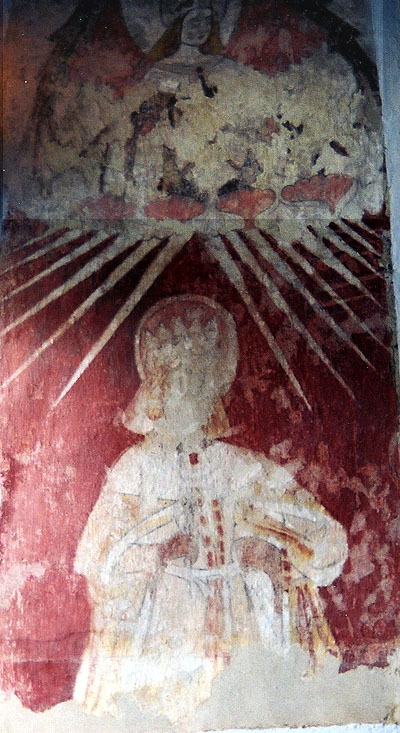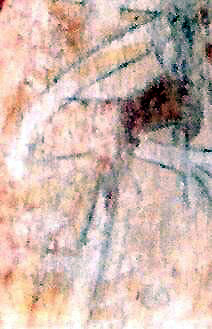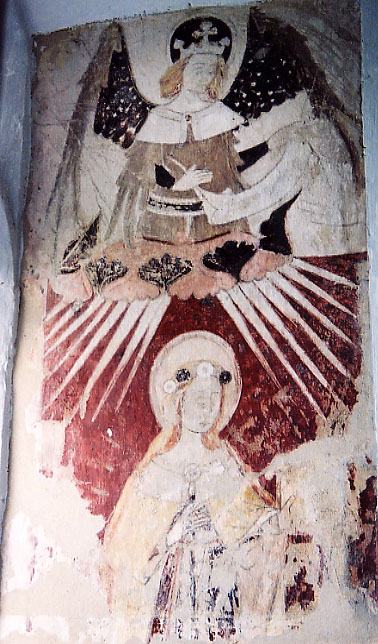Gisleham, Suffolk (†Norwich) Late C.14/Early C.15
An Angel Blessing St Walstan of Bawburgh (or St Edmund)?
and The Annunciation?

I still cannot identify these mysterious paintings with absolute certainty. Each is painted in a window-splay on the north wall of the church, with an empty splay where paintings may once have been facing each one, and space below where more details might once have been. But the upper figure in the painting at the left (north wall, western window) has now been revealed as unquestionably an angel, with very large dramatic wings, and quite definitely not the Virgin Mary. Stylised clouds separate this figure from that below, and great shafts of light radiate down from them, framing the head of a crowned male figure. The most significant detail is the object he holds in his right hand, which I originally suggested might be a scythe or sickle, making him St Walstan of Bawburgh:
“If this is so, then he is very likely to be St Walstan of Bawburgh, a saint whose cult was once thought to be confined almost exclusively to Norfolk, not Suffolk¹, although according to his legend, Walstan was born in Suffolk, the son of a prince at Blythburgh. Walstan embraced poverty, and sought work as a farm labourer, becoming in due course renowned for his prayers for sick people and cattle alike. Two calves are said to have drawn his body on a cart to burial, passing through a solid wall in the process. Despite his acquired humble station, East Anglian screens² show him crowned and with a sceptre, and the painter here seems to have taken the same line, giving Walstan aristocratic robes as well as his scythe…”

It should be stressed that Walstan is still a possibility, but revision and minute scrutiny of all the available photographs has suggested another candidate, and I now suspect that this might in fact be St Edmund of East Anglia, holding several arrows (detail, left). If this is true, then the ‘scythe or sickle’ is nothing of the kind, and might be, rather, part of a looping scroll with a long-vanished inscription, which once curved around the saint’s arm and continued lower down his torso. Or it might even simply be the border of his cloak.

It is impossible to be sure, and likely to remain so. A (wingless) St Michael Weighing Souls can be ruled out, I think, but this could of course be another male saint entirely.
The painting below at the right, further east on the north wall and therefore nearer the altar, is probably the Annunciation. In this case, the figure in the clouds is the Archangel Gabriel, crowned as a saint. He holds a broad scroll, the inscription on it unfortunately no longer decipherable.
Below, the Virgin wears a flower-wreath on her head (the dark flowers were almost certainly once red or blue) and the object to the right of her is probably a lectern with a book, thus showing her in the act of reading as at nearby Barnby. Again, there is no certainty here, but the attention-demanding breadth of the angel’s scroll is testimony to the importance of the message on it.
The paintings – the only ones now remaining at Gisleham – are of high quality, and the very striking rays of light are comparable on this site only with those marking the ascent of St Erasmus’s soul to heaven at Chippenham. They also have an un-English look about them that is hard to define but detectable. It seems to me very likely that French or Flemish painters were working in this corner of East Anglia, and nearby Belton’s Three Living & Three Dead, unfortunately now represented only by a modern copy, is also a strong candidate for ascription to a Continental painter.
¹ The only known wall painting of Walstan is at Cavenham in West Suffolk, and he appears on a screen at Foxearth in Essex. As far afield as Clwyd (formerly Denbighshire) in Wales a stone figure with a scythe at All Saints, Gresford, is said to be the saint. The likelihood is that other representations of him will be found elsewhere. Carol Twinch, In Search of St Walstan: East Anglia’s Enduring Legend, Media Associates, Norwich, 1995. (New edition in preparation).
² e.g. Barnham Broom, Ludham, Sparham (all Norfolk)